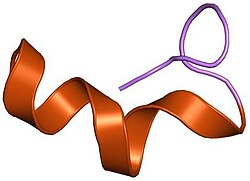Endothelin 1
Endothelin 1 (ET-1), also known as preproendothelin-1 (PPET1), is a potent vasoconstrictor that in humans is encoded by the EDN1 gene and produced by vascular endothelial cells. The protein encoded by this gene is proteolytically processed to release a secreted peptide termed endothelin 1. Endothelin 1 is one of three isoforms of human endothelin.
Source[]
Preproendothelin is precursor of the peptide ET-1. Endothelial cells convert preproendothelin to proendothelin and subsequently to mature endothelin, which the cells release.[5]
Clinical significance[]
Long term ET-1 exposure has been associated with hypertrophic cardiomyopathy.[6]
Endothelin-1 receptor antagonists (Bosentan) are used in the treatment of pulmonary hypertension. Inhibition of these receptors prevents pulmonary vasculature constriction and thus decreases pulmonary vascular resistance.
References[]
- ^ a b c GRCh38: Ensembl release 89: ENSG00000078401 - Ensembl, May 2017
- ^ a b c GRCm38: Ensembl release 89: ENSMUSG00000021367 - Ensembl, May 2017
- ^ "Human PubMed Reference:". National Center for Biotechnology Information, U.S. National Library of Medicine.
- ^ "Mouse PubMed Reference:". National Center for Biotechnology Information, U.S. National Library of Medicine.
- ^ Boulpaep EL, Boron WF (2009). Medical physiology: a cellular and molecular approach. Saunders/Elsevier. ISBN 978-1-4160-3115-4.
- ^ Archer CR, Robinson EL, Drawnel FM, Roderick HL (August 2017). "Endothelin-1 promotes hypertrophic remodelling of cardiac myocytes by activating sustained signalling and transcription downstream of endothelin type A receptors". Cellular Signalling. 36: 240–254. doi:10.1016/j.cellsig.2017.04.010. PMC 5486433. PMID 28412414.
Further reading[]
- Bruno CM, Neri S, Di Prima P, Sciacca C (June 2003). "Pathophysiology of endothelin and medical emergencies". Panminerva Medica. 45 (2): 151–4. PMID 12855940.
- Doggrell SA (June 2004). "The endothelin system and its role in acute myocardial infarction". Expert Opinion on Therapeutic Targets. 8 (3): 191–201. doi:10.1517/14728222.8.3.191. PMID 15161426. S2CID 23993694.
- Beghetti M, Black SM, Fineman JR (May 2005). "Endothelin-1 in congenital heart disease". Pediatric Research. 57 (5 Pt 2): 16R–20R. doi:10.1203/01.PDR.0000160447.83332.13. PMID 15817494.
- Cazaubon S, Deshayes F, Couraud PO, Nahmias C (April 2006). "[Endothelin-1, angiotensin II and cancer]". Médicine/Sciences. 22 (4): 416–22. doi:10.1051/medsci/2006224416. PMID 16597412.
- Ariza AC, Bobadilla NA, Halhali A (2007). "[Endothelin 1 and angiotensin II in preeeclampsia]". Revista de Investigacion Clinica. 59 (1): 48–56. PMID 17569300.
- Davenport AP, Hyndman KA, Dhaun N, Southan C, Kohan DE, Pollock JS, et al. (April 2016). "Endothelin". Pharmacological Reviews. 68 (2): 357–418. doi:10.1124/pr.115.011833. PMC 4815360. PMID 26956245.
- Han SG, Ko S, Lee WK, Jung ST, Yu YG (August 2017). "Determination of the endothelin-1 recognition sites of endothelin receptor type A by the directed-degeneration method". Scientific Reports. 7 (1): 7577. Bibcode:2017NatSR...7.7577H. doi:10.1038/s41598-017-08096-6. PMC 5548930. PMID 28790412.
External links[]
- Overview of all the structural information available in the PDB for UniProt: P05305 (Endothelin-1) at the PDBe-KB.
This article incorporates text from the United States National Library of Medicine, which is in the public domain.
- Genes on human chromosome 6
- Endothelin receptor agonists
- Human chromosome 6 gene stubs





